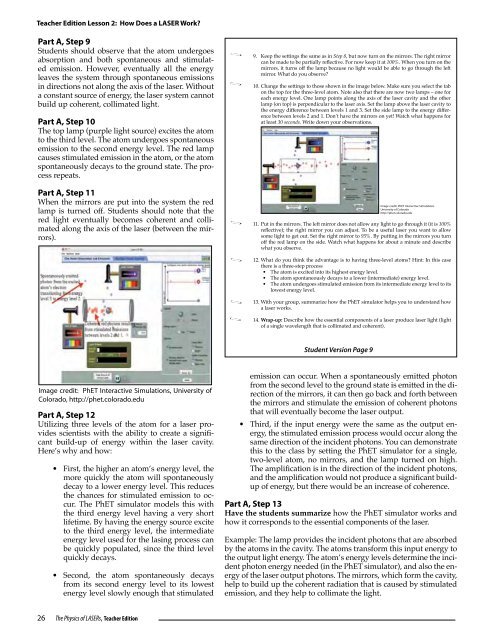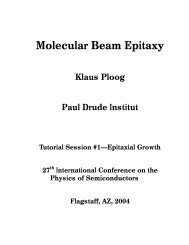The Physics of LASERs - American Physical Society
The Physics of LASERs - American Physical Society
The Physics of LASERs - American Physical Society
You also want an ePaper? Increase the reach of your titles
YUMPU automatically turns print PDFs into web optimized ePapers that Google loves.
Teacher Edition Lesson 2: How Does a LASER Work?<br />
Part A, Step 9<br />
Students should observe that the atom undergoes<br />
absorption and both spontaneous and stimulated<br />
emission. However, eventually all the energy<br />
leaves the system through spontaneous emissions<br />
in directions not along the axis <strong>of</strong> the laser. Without<br />
a constant source <strong>of</strong> energy, the laser system cannot<br />
build up coherent, collimated light.<br />
Part A, Step 10<br />
<strong>The</strong> top lamp (purple light source) excites the atom<br />
to the third level. <strong>The</strong> atom undergoes spontaneous<br />
emission to the second energy level. <strong>The</strong> red lamp<br />
causes stimulated emission in the atom, or the atom<br />
spontaneously decays to the ground state. <strong>The</strong> process<br />
repeats.<br />
Part A, Step 11<br />
When the mirrors are put into the system the red<br />
lamp is turned <strong>of</strong>f. Students should note that the<br />
red light eventually becomes coherent and collimated<br />
along the axis <strong>of</strong> the laser (between the mirrors).<br />
Image credit: PhET Interactive Simulations, University <strong>of</strong><br />
Colorado, http://phet.colorado.edu<br />
Part A, Step 12<br />
Utilizing three levels <strong>of</strong> the atom for a laser provides<br />
scientists with the ability to create a significant<br />
build-up <strong>of</strong> energy within the laser cavity.<br />
Here’s why and how:<br />
26<br />
• First, the higher an atom’s energy level, the<br />
more quickly the atom will spontaneously<br />
decay to a lower energy level. This reduces<br />
the chances for stimulated emission to occur.<br />
<strong>The</strong> PhET simulator models this with<br />
the third energy level having a very short<br />
lifetime. By having the energy source excite<br />
to the third energy level, the intermediate<br />
energy level used for the lasing process can<br />
be quickly populated, since the third level<br />
quickly decays.<br />
• Second, the atom spontaneously decays<br />
from its second energy level to its lowest<br />
energy level slowly enough that stimulated<br />
<strong>The</strong> <strong>Physics</strong> <strong>of</strong> <strong>LASERs</strong>, Teacher Edition<br />
Student Edition Lesson 2: How Does a LASER Work?<br />
9. Keep the settings the same as in Step 8, but now turn on the mirrors. <strong>The</strong> right mirror<br />
can be made to be partially reflective. For now keep it at 100%. When you turn on the<br />
mirrors, it turns <strong>of</strong>f the lamp because no light would be able to go through the left<br />
mirror. What do you observe?<br />
10. Change the settings to those shown in the image below. Make sure you select the tab<br />
on the top for the three-level atom. Note also that there are now two lamps – one for<br />
each energy level. One lamp points along the axis <strong>of</strong> the laser cavity and the other<br />
lamp (on top) is perpendicular to the laser axis. Set the lamp above the laser cavity to<br />
the energy difference between levels 1 and 3. Set the side lamp to the energy difference<br />
between levels 2 and 1. Don’t have the mirrors on yet! Watch what happens for<br />
at least 30 seconds. Write down your observations.<br />
11. Put in the mirrors. <strong>The</strong> left mirror does not allow any light to go through it (it is 100%<br />
reflective); the right mirror you can adjust. To be a useful laser you want to allow<br />
some light to get out. Set the right mirror to 95%. By putting in the mirrors you turn<br />
<strong>of</strong>f the red lamp on the side. Watch what happens for about a minute and describe<br />
what you observe.<br />
12. What do you think the advantage is to having three-level atoms? Hint: In this case<br />
there is a three-step process<br />
• <strong>The</strong> atom is excited into its highest energy level.<br />
• <strong>The</strong> atom spontaneously decays to a lower (intermediate) energy level.<br />
• <strong>The</strong> atom undergoes stimulated emission from its intermediate energy level to its<br />
lowest energy level.<br />
13. With your group, summarize how the PhET simulator helps you to understand how<br />
a laser works.<br />
14. Wrap-up: Describe how the essential components <strong>of</strong> a laser produce laser light (light<br />
<strong>of</strong> a single wavelength that is collimated and coherent).<br />
Student Version Page 9<br />
Image credit: PhET Interactive Simulations<br />
University <strong>of</strong> Colorado<br />
http://phet.colorado.edu<br />
<strong>The</strong> <strong>Physics</strong> <strong>of</strong> <strong>LASERs</strong> 9<br />
emission can occur. When a spontaneously emitted photon<br />
from the second level to the ground state is emitted in the direction<br />
<strong>of</strong> the mirrors, it can then go back and forth between<br />
the mirrors and stimulate the emission <strong>of</strong> coherent photons<br />
that will eventually become the laser output.<br />
• Third, if the input energy were the same as the output energy,<br />
the stimulated emission process would occur along the<br />
same direction <strong>of</strong> the incident photons. You can demonstrate<br />
this to the class by setting the PhET simulator for a single,<br />
two-level atom, no mirrors, and the lamp turned on high.<br />
<strong>The</strong> amplification is in the direction <strong>of</strong> the incident photons,<br />
and the amplification would not produce a significant buildup<br />
<strong>of</strong> energy, but there would be an increase <strong>of</strong> coherence.<br />
Part A, Step 13<br />
Have the students summarize how the PhET simulator works and<br />
how it corresponds to the essential components <strong>of</strong> the laser.<br />
Example: <strong>The</strong> lamp provides the incident photons that are absorbed<br />
by the atoms in the cavity. <strong>The</strong> atoms transform this input energy to<br />
the output light energy. <strong>The</strong> atom’s energy levels determine the incident<br />
photon energy needed (in the PhET simulator), and also the energy<br />
<strong>of</strong> the laser output photons. <strong>The</strong> mirrors, which form the cavity,<br />
help to build up the coherent radiation that is caused by stimulated<br />
emission, and they help to collimate the light.
















